The world of fishkeeping may be an intimidating experience for beginners; therefore, it is always a good idea, to begin with, for fish that require less attention and care. When getting started with fish keeping, try to choose the best and easiest fish to take care of.
This can help alleviate some of the worries that are involved with beginners. Fish that require less care and attention are often resilient and are more tolerant of inexperienced fish keepers’ errors. So, it’s better to opt for low-maintenance fish initially.
Let’s move on to discuss the 32 easiest low-maintenance fish to take care of.
What Is A Beginner-Friendly Fish?

Beginner-friendly freshwater fish are those species that are easy to maintain, peaceful, small-sized, get well with other fish and have a hardy/sturdy nature that can thrive well in a wide range of conditions.
Normally, all the fish species are divided into two main categories, i.e., freshwater and saltwater fish. Let’s dive into low-maintenance fish of both these types.
32 Beginner-Friendly Freshwater Fish
Are you new to fishkeeping and looking for the best options to start with? In this post, we’ll be highlighting a variety of freshwater fish that are perfect for beginners, including their care requirements and compatibility with other species. Whether you’re looking to set up your first aquarium or simply looking for some new additions to your existing tank, this post has got you covered.
Here are all the beginner-friendly freshwater fish:
1. Swordtails

Swordtail fish are a stunning kind of freshwater fish that are pretty popular in the community of aquarium keepers. These fish are beautiful options for beginners (or pros who don’t want any fuss) because of the minimal level of upkeep they require and the natural beauty they possess.
These are freshwater fish that are about medium in size. When they mature, swordtail fish typically measure between 5.5 and 6.5 inches in length. Fish with swordtails are brightly colored and have streamlined bodies. They aren’t going to bother anyone and are fantastic additions to community aquariums.
2. Bloodfin Tetras

When you look at the bloodfin tetra, it’s easy to see where it gets its name. Along the edge of the anal fin, both males and females have a reddish patch. The red can also spread to the fish’s pelvic, ventral, and tail fins; however, this depends on the fish’s overall health and how old it is.
Bloodfin tetras are commonly available in the pet trade as juveniles. They grow to be about 2 inches long, which is a good size for tetra fish.
Bloodfin tetras can withstand freezing temperatures, which is rare for tetra fish.
3. Cherry Barb (Puntius titteya)
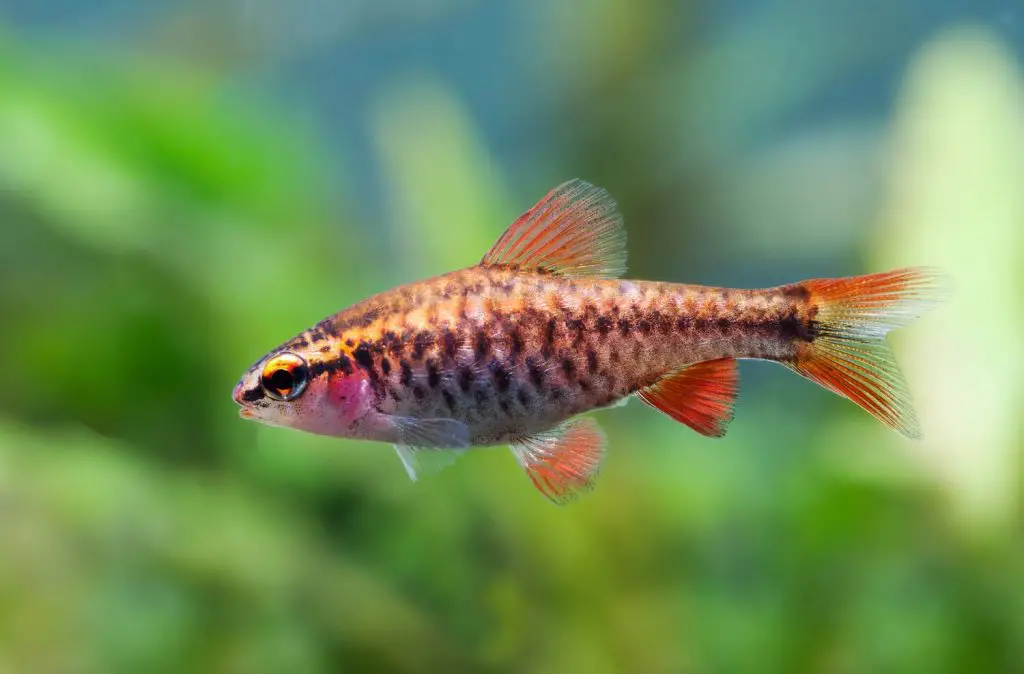
Certain pet retailers may classify cherry barbs as semi-aggressive, but you can feel confident that they will not make your tank a terrible place. However, they have been known to harass fish that move slowly and have long fins, so if you have animals like these in your tank, you might want to keep away from these creatures. You shouldn’t have any problems as long as you have active fish like the ones.
However, they will congregate together when they sense that they are in danger, whether from a change in the water or larger fish. The color of the females is more subdued, but the males have a more vibrant red hue. The colors of the males truly make them stand out from the background.
4. Cory Catfish (Corydoras)

Cory Catfish is another best fish for beginners. Although many species of Corydoras belong to this genus, the panda cory, also known as the bronze cory and the albino cory, are considered to be three of the tamest members. Bottom feeders like these several species of catfish spend their days quietly foraging around the surface in search of morsels of food.
These peaceful fish are happiest in groups of at least three of their kind, making them ideal for community aquariums. The average size is only 1-2 inches.
They are pretty adaptable in terms of the chemistry of the water and the temperature; nonetheless, they thrive in an environment with a temperature range of 74 to 82 degrees and a pH of 6.5 to 7.7. The capacity of their tank needs to be at least twenty gallons.
These easy-to-breed fish aren’t picky about diet but appreciate worms and sinking pellets.
5. Bushynose Pleco

The little bushy-nose pleco, which belongs to the distinguished family of catfish, has risen to significant popularity among fish aficionados due to its capacity to prevent the growth of algae in fish tanks despite its tiny size.
These bottom-feeding fish do best in large tanks with many places to hide and shade. It is preferable to avoid having two male fish in the same aquarium since they have the potential to become aggressive against one another and their territory, although they are mostly calm.
The algae growing on surfaces is the primary source of nutrition for bushy nose plecos; nevertheless, they also need a little bit of protein in their meals.
6. Common Guppy (Poecilia Reticulata)

Aquarists prize guppies because they are hardy and beautiful. These live-bearing fish have calm demeanors and can adapt to various environmental circumstances, so they do well in community aquariums.
7. Firemouth Cichlid (Thorichthysmeeki)

Firemouth cichlids are colorful fish from Central America. The glittering scales on their back and the flaming throat of this creature catch your attention, especially when they compete against one another by flaring their gills and fins at one another.
They can also survive in various water conditions, so there’s no need to buy additional supplies or adjust the water you currently have for them.
They, like other cichlids, have the potential to be aggressive, particularly during the mating process. But the aggression won’t last long if you put fish in a tank that is about the same size.
8. King Tiger Pleco (Hypancistrus sp)

King Tiger Plecostomus are good for most beginners because they are the easiest fish to take care of in a small tank. It may appear like a jungle tiger, but it does not behave like one at all. Instead, it is calm and reserved and prefers to stake its territory on the bottom of the tank, where it will enjoy some peace.
Even though it is normally peaceful, it occasionally fights its members for territory when competing. But once they’ve marked their boundaries, everything is fine unless someone tries to sneak in. If you want to recreate the conditions of their native environment, you should give them places to hide but not excessive aquatic habitats.
9. Harlequin Rasbora (Trigonostigmaheteromorpha)

These lovely fish make excellent tankmates. They may grow to be around two inches long and are fairly tame due to their size. Their unique look comes from the fact that they are black and metallic orange.
They are hardy little fish that do well on flake meals and are friendly enough to get along with almost anything that doesn’t try to eat them.
10. Neon Tetra (Paracheirodoninnesi)
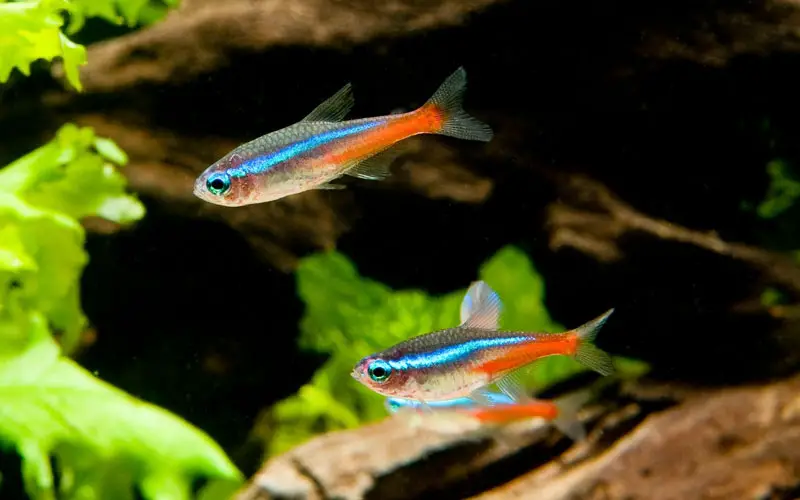
Everyone’s first concern as a beginner is their budget. As a result, they are cheap, adaptable, and incredibly simple to care for. Their history goes back hundreds of years and can be found worldwide.
They require higher water temperatures and a somewhat acidic water pH, just like most other tetras. They have a high level of disease resistance and are simple to maintain. Because they evolved in the Amazon River Basin, it should not be surprising that they require year-round temperatures in the tropical water they inhabit.
11. Zebra Danio (Danio Rerio)

Zebra Danios are an adorable kind of long-bodied fish that often have black and silvery-blue horizontal stripes along the length of their bodies. Zebra Danios occur in a long-finned variation and brilliant, intriguing “Glofish” hues. These fish are also the easiest fish to take care of in a bowl.
This shoaling fish is simple to care for and can flourish at colder water temperatures, so a heater is not usually needed. They are wonderful additions to community aquariums.
12. Southern Platyfish (Xiphophorus Maculatus)
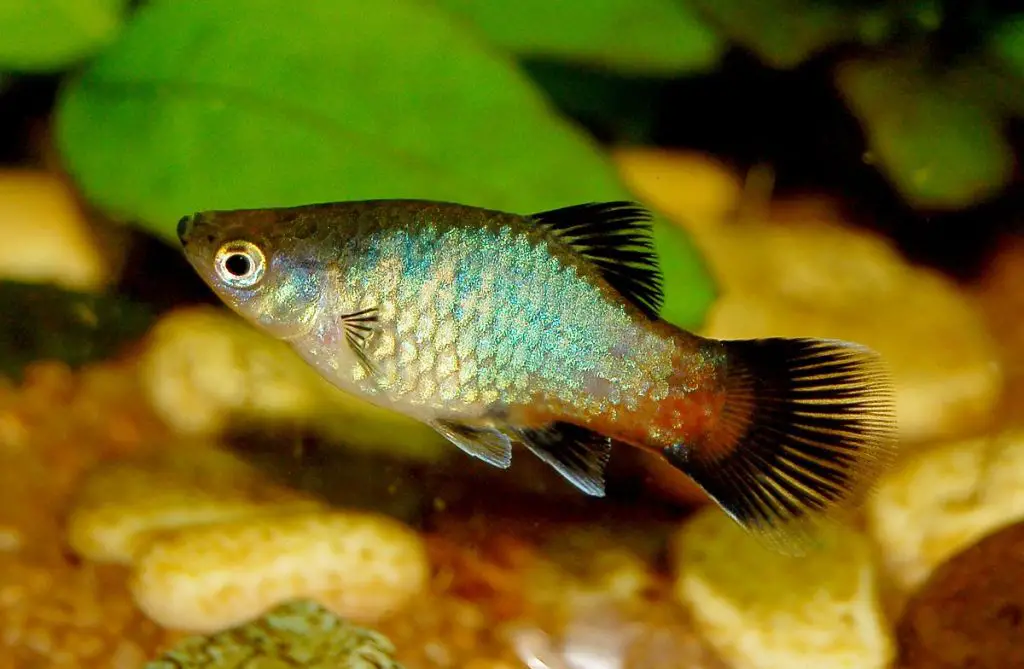
They are lively fish that get along well with other tank inhabitants and give a splash of color to the environment. These robust fish enjoy common aquariums because of their adaptability. They survive best in an area that is densely planted and has a substrate composed of gravel.
The platyfish is an omnivore that has a penchant for herbivorous diets. They can eat a meat-based diet, but a diet rich in veggies also serves best.
13. Common Molly (Poeciliasphenops)

The Common Molly is easy to breed, tough, and widely available, making this another noteworthy addition to our list. Like other livebearers, they are able to adapt to a wide variety of water conditions, making them appropriate for beginners. Additionally, these fish are the easiest fish to take care of without a filter.
Though Mollies are usually friendly, shoals should be mostly female as males may act aggressively.
14. Dwarf Neon Rainbow Fish

The neon rainbow, like other fish, is suitable for beginners. They are the easiest pet fish to take care of. It can live in different water environment as long as they aren’t too acidic, even though it likes more challenging water.
Their adaptability also extends to the foods that they consume. They can survive on a diet consisting of ordinary fish food, but they will also gladly consume the rare bloodworm and brine shrimp if given the opportunity.
15. Green Swordtail (Xiphophorus Hellerii)

The Green Swordtail fish gets its name from its sword-like caudal fin. But only the males of this species have this unique feature. The Green Swordtail is recognized for its calm and friendly demeanor, regardless of whether it is a male or female. It is a resilient fish perfect for first-time owners, as with most live-bearing species.
16. Kuhli Loach

One of the most interesting and rare freshwater aquarium fish species is the Kuhli loach. They are one of the best fish for a small tank. They are also the easiest freshwater fish to take care of. Additionally, they are not connected to eels in any way, despite their appearance.
Most Kuhli Loaches move around at night. So they won’t be around much during the day. If you keep 3 or 4 Kuhli loaches together, they will be more active during the day. Food taste is another factor that encourages them to begin their search.
One further reason that Kuhli Loaches are the perfect fish for the beginner is that they remain tiny. When they reach their maximum length of 3-5 inches, a group may survive well in an aquarium that is 20 gallons in size.
Low-Maintenance Saltwater Fish
Here are all the saltwater fish that are easy for beginners to attract:
17. Angel Fish
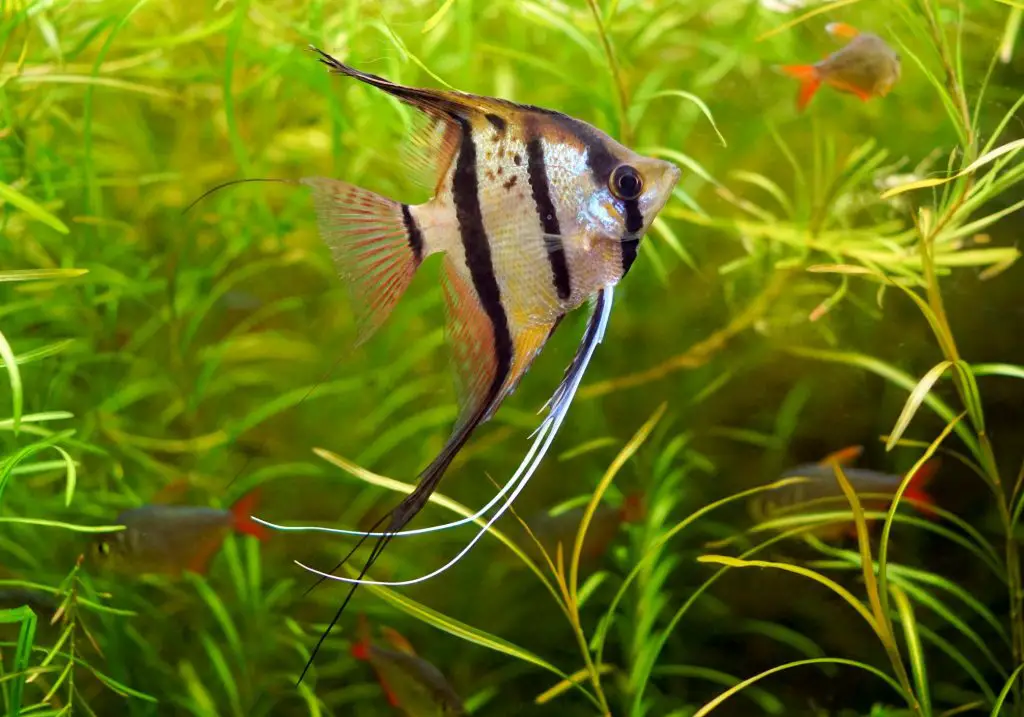
Many say Angelfish are hard to care for, but that’s not true. Because they may reach a length of up to 15 centimeters (about 6 inches), you will need a tank that is rather large to house them. These fish are omnivores and will consume almost anything they can get their mouths on, whether it be plant life or animal life, living or dead.
18. Betta Fish
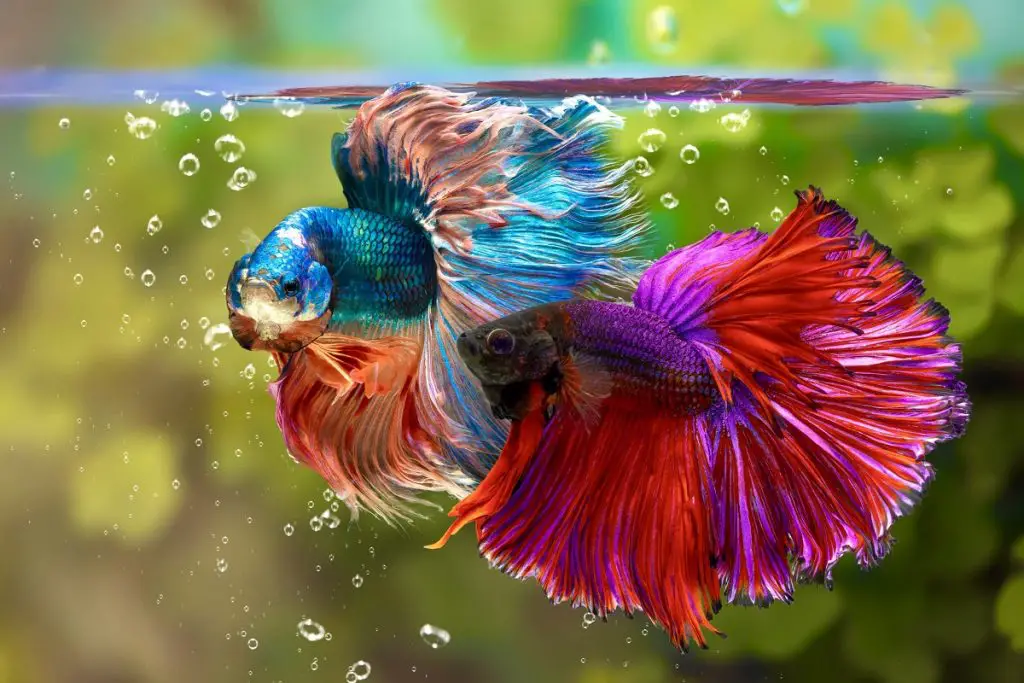
Even though they’re one of the best fish to care for, your betta fish will live longer and happier with a few changes to their fishbowl. Bettas require a tank that has at least five gallons in size and is equipped with a filter and a heater.
Bettas are tropical fish; thus, the ideal temperature range for their tank is between 78 and 82 Fahrenheit. Make sure your fish tank has a thermometer and not one of those stick-on gauges that aren’t reliable.
Because of their long, fragile fins, betta fish are susceptible to injury while swimming in water with a strong current. Use a filter of the proper size and either completely stop the flow of water or redirect it so that your betta is not disturbed by the movement of the water.
Sharp ornamental things in the environment readily rip their fins. When you run your finger over any prospective decoration, you shouldn’t feel any solid or pointed protrusions sticking out of it. If you are concerned, you should decorate with items that are betta-specific. Betta fish grow about 3-4 inches long, so make sure their decoration fits as they do.
19. Goldfish

Goldfish may be found in various colors, sizes, and patterns. Goldfish have the potential to live for a very long period if they are properly cared for.
Goldfish are known to like swimming and living in bodies of water, such as lakes and ponds, so you can be confident that they can adapt to various settings.
If you want to keep your goldfish alive for a longer period than you would be able to if you kept them in a lake, you should keep them in a conventional fish tank because goldfish are used to living in more hostile surroundings.
During the Song dynasty in ancient China, a silver-colored carp was crossed with a goldfish to produce the first goldfish. Soon after, a color mutation occurred, ultimately responsible for the yellow and orange colors characteristic of goldfish today.
20. Danios or Zebra Danios

Zebra Danios are highly desired due to their recognizable striped markings, active swimming habit, and low maintenance requirements. They do well in pH-neutral water and can survive in aquariums with both tropical and cold water that is not heated.
Zebra Danios are most lively when housed in small schools. Because they are active at all times, it is advised that you have a tank that is at least 20 gallons in capacity.
21. Mollies

Mollies are a species of livebearer distinguished by their greater size and more powerful physique than their more streamlined counterparts, the Guppy. They can, however, reproduce quickly and are happy in freshwater tanks. Mollies come in several colors and designs, so you may select one to fit your tank.
22. Plecos

Plecos are among the most desirable fish to keep in a freshwater aquarium, and they may thrive either on their own or in communal environments. The fact that these calm, bottom-dwelling fish have a voracious hunger for algae has garnered them a lot of admiration from people.
They will maintain your aquarium’s cleanliness and ensure your plants’ health. In addition, Plecos are available in a wide range of sizes, hues, and patterns. They also like to stay to themselves, which means that the other fish in the aquarium aren’t bothered by their presence.
Even while most species never grow to be more than a few inches in length, they are still beautiful, vibrant, and a fantastic tool for maintaining the cleanliness of your aquarium.
23. White Cloud Minnows
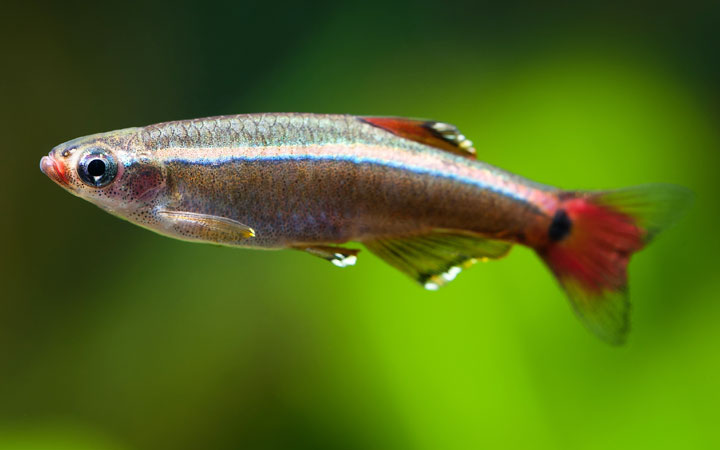
Some call white cloud mountain minnows “Poor Man’s Neon Tetras.” But in just a few years, they have become popular.
They are freshwater aquarium fish that are calm despite their energetic nature. Their colors are soft, with white stripes that reflect light and bright red fins.
There’s a good chance that white cloud mountain minnows are the most resilient fish. They can flourish and even reproduce in most types of water composition.
But they can live with fish that don’t try to eat them. The 45 to 75 degrees Fahrenheit temperature range is ideal for mountain minnows.
24. Guppies

One of the best fish for breeding in freshwater aquariums at home are these little livebearers. They’re colorful, energetic, can survive in bad water, and have basic demands. It’s essential to give your Guppy fry a lot of plant cover if you want them to live.
Guppies are often sick when they come from pet stores because they have been bred to have unique colors and patterns. However, after they have adapted to their new surroundings, these fish are very hardy.
25. Green Chromis (ChromisViridis)

Most aquariums have a Green Chromis for a good reason. These friendly fish are ideal companions for other peaceful species and may even coexist in shallows with other fish in the aquarium.
The Green Chromis is a very good fish for people just starting because it is hardy. They also eat almost any kind of food and are called omnivores.
26. Clownfish (Ocellaris Clownfish)

Clownfish are low-maintenance due to their small size and hardiness. These small fish rarely grow longer than 4 inches, which lets them do well in 20-gallon aquariums.
Clownfish are usually found in community tanks with other fish that is also calm and quiet. However, it is essential to remember that various clownfish species should not be housed in the same aquarium because this may promote territorial behavior.
27. Damsel Fish

The damselfish is low-maintenance and resilient to beginners. Because they are omnivores, they require very little attention regarding their diet.
Due to its aggressive nature, it should be kept alone or with other aggressive fish. This will provide an atmosphere that is risk-free and secure for all of your fish.
28. Elegant Firefish

This lovely species is generally considered a calm fish to keep around. They get along with most fish but may attack their kind.
Elegant firefish aren’t too picky about what they eat but do best when they eat meat. Feed them a protein-rich diet regularly to keep them healthy.
29. Lawnmower Blenny (Salarias Fasciatus)

With its unique look and algae-eating habits, the lawnmower blenny has won over marine aquarists worldwide. On the other hand, they are also among the fish requiring the least maintenance.
They are great for beginners because they can handle small changes in the water. Before bringing lawnmower blennies into their new environment, however, ensuring that the aquarium has a healthy algae population and has been established for a suitable amount of time is essential.
30. Yellow Watchman Goby (Poecilia Reticulata)
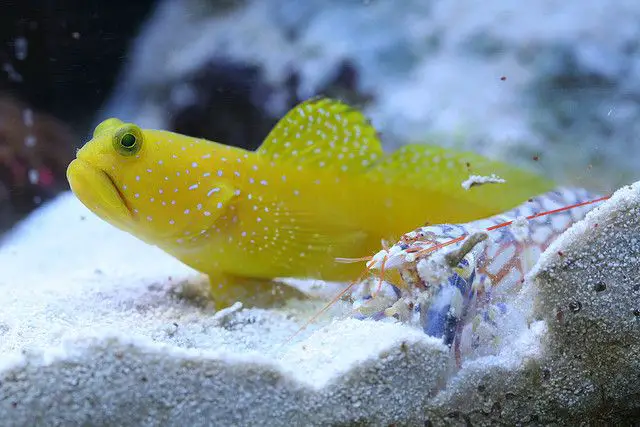
In the natural environment, this beautiful fish lives the relationship of the pistol. The goby warns the shrimp of danger while the shrimp builds the house for the goby.
In an aquarium, the Yellow Goby live well with other species if the other species are not hostile and violent toward them. The best way to house these fish in an aquarium is to provide them a pistol shrimp or keep them in pairs.
31. Chalk Bass (Serranus Tortugarum)
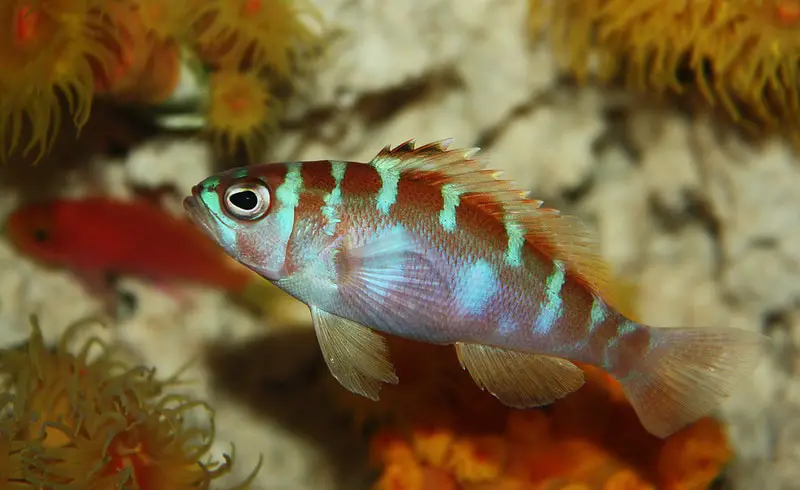
The maximum length of a Chalk Bass is three inches, and they are wonderful additions to the aquarium of anyone just starting. These peaceful fish can be maintained singly or in groups depending on your preference. When housed in an aquarium with other fish and corals, they are well-behaved and won’t bother the other tank inhabitants.
This peaceful fish gets along best with other fish with similar personalities. If you stay away from aggressive or territorial fish, your fish will be happy and healthy.
This is because Chalk Bass can endure modest water changes. In addition to this, it is resistant to sicknesses. This an excellent option for marine fish aficionados looking for a simple fish to care for!
32. Pajama Cardinal Fish (Sphaeramianematoptera)

These brightly colored fish with spots are among the most popular species kept as pets for an excellent reason – they have a wonderful disposition.
Species that want to live together peacefully would make excellent tankmates.
Tips That Every Beginner Fishkeeper Should Know
Make sure the fish you want to buy can survive in the environment of the tank you have. Find out how big it can get, what kind of water it likes, and what it needs to eat before you buy it.
Check to see whether the new fish will get along with the ones you already have, and inquire as to whether or not they can interact with others of their own type.
Don’t Always Trust Your Local Fish Store Staff
When you’re starting, asking the fish store workers for advice might be appealing.
Unfortunately, fish store staff frequently propose what’s in stock rather than the best species for you. Fish that require varying degrees of maintenance are commonly sold at retail outlets.
If you depend on what the fish store has, you may end up selecting fish based on what is available rather than what is best. This could lead you to fish that have particular needs.
Cycle A New Aquarium
Cycling a new aquarium gives you the best chance of success because it ensures that your tank has all the good bacteria needed to keep nitrite and nitrogen levels at the correct levels. This must be done to keep your fish in good health.
As a beginner aquarium owner, you might be tempted to avoid the cycling process altogether because it takes many weeks to complete. But if you are patient, you will get nitrifying bacteria to help you build your desired aquarium.
Smaller Tanks Are Not Simpler To Keep Healthy
The size of your aquarium significantly affects how clean the water is. Smaller tanks are more likely to overcrowd and overfeed, leading to excess ammonia and nitrification.
This is a hazardous move since it can cause illness or even cause your fish to die if left unchecked. It is simpler to maintain their health while they are larger. Therefore, make a selection based on the quantity of fish you own.
Conclusion
Keeping fish in freshwater as well as saltwater aquariums can be a gratifying and fun hobby, but it also takes a lot of work. You must be able to select an excellent fish for beginners and set up your tank in the appropriate manner after reading this comprehensive guide.
FAQs
What is the most low-maintenance fish?
White cloud minnows, neon tetras, and goldfish species are some of the easiest fish to take care of.
What is the hardiest pet fish?
Zebra Danios are just about the hardiest pet fish you’ll ever keep.
What are the top 10 easiest fish to care for?
These are the top 10 easiest fish to care for:
- Swordtails
- Bloodfin Tetras
- Cherry Barb
- Cory Catfish
- Bushynose Pleco
- Common Guppy
- Firemouth Cichlid
- King Tiger Pleco
- Harlequin Rasbora
- Neon Tetra
What is the friendliest aquarium fish?
Neon Tetras are the friendliest aquarium fish.

